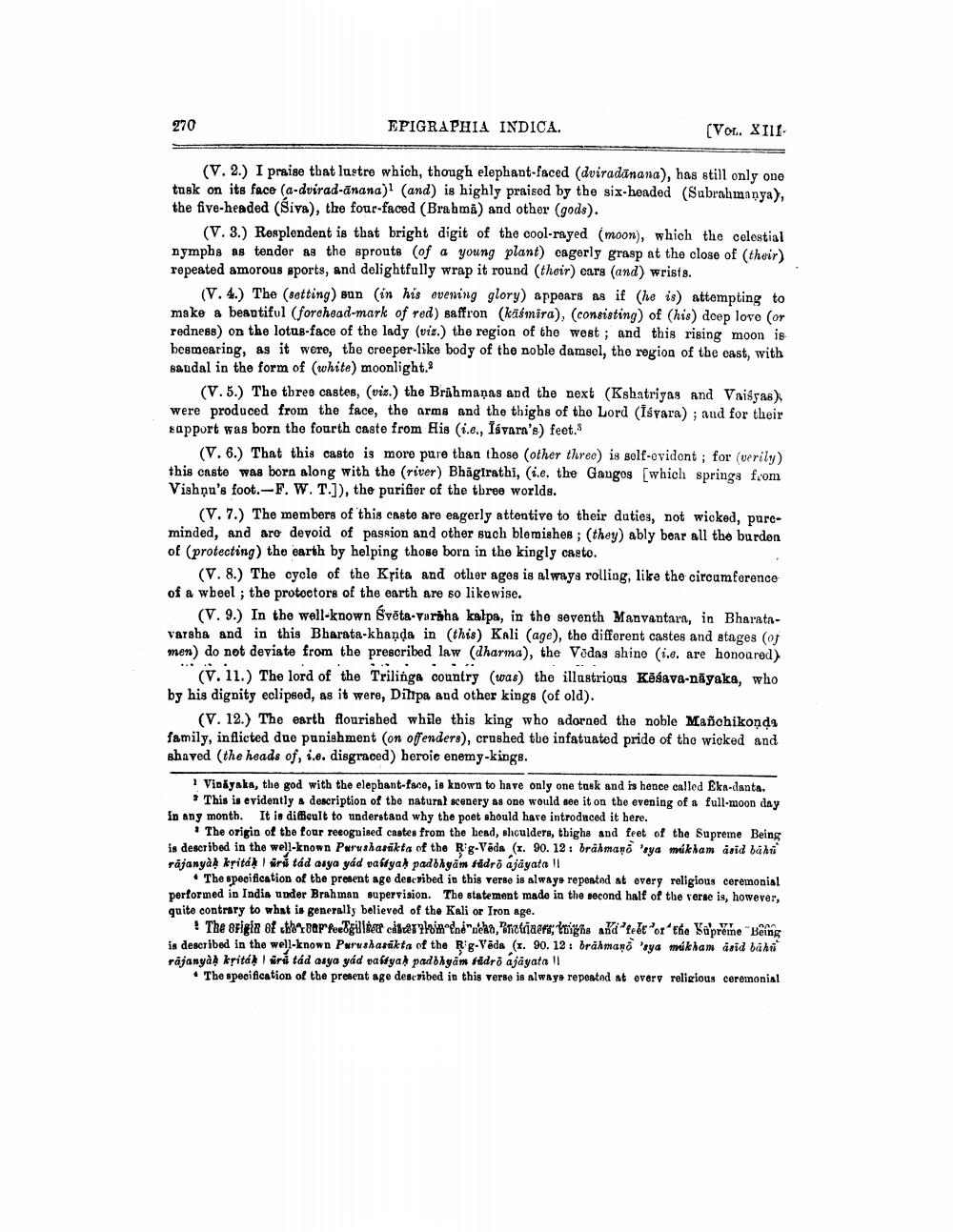________________
270
EPIGRAPHIA INDICA.
(VOL. XIII
(V. 2.) I praise that lustre which, though elephant-faced (dviradānana), has still only one task on its face (a-dvirad-ānana)' (and) is highly praised by the six-headed (Subrahmanya), the five-headed (Siya), the four-faced (Brahma) and other (gods).
(V. 3.) Resplendent is that bright digit of the cool-rayed (moon), which the celestial nymphs as tender as the sprouts (of a young plant) cagerly grasp at the close of (their) repeated amorous sports, and delightfully wrap it round (their) ears (and) wrists.
(V. 4.) The setting) sun (in his evening glory) appears as if (he is) attempting to make a beautiful (forehead-mark of red) saffron (kiếmira), (consisting) of (his) doep love (or redness) on the lotus-face of the lady (viz.) the region of the west ; and this rising moon is besmearing, as it were, the creeper-like body of the noble damsel, the region of the east, with saudal in the form of (white) moonlight.
(V.5.) The three castes, (vis.) the Brāhmaṇas and the next (Kshatriyas and Vaissas) were produced from the face, the arms and the thighs of the Lord (Isvara); and for their support was born the fourth caste from His i.e., Isvara's feet.
(V. 6.) That this casto is more pare than thoso (other three) is self-evident; for (verily) this caste was born along with the (river) Bhagirathi, i.e. the Gaugos (which springs from Vishnu's foot.-F. W. T.]), the purifier of the tbree worlds.
(V. 7.) The members of this caste are eagerly attentive to their duties, not wicked, pureminded, and are devoid of passion and other such blemishes ; (they) ably bear all the burden of protecting) the earth by helping those born in the kingly casto.
(V. 8.) The cycle of the Krita and other ages is always rolling, like the circumference of a wheel; the protectors of the earth are so likewise.
(V. 9.) In the well-known Svēta varðha kalpa, in the seventh Manvantar, in Bharatavarsha and in this Bharata-khanda in (this) Kali (age), the different castes and stages of men do not deviate from the prescribed law (dharma), the Vodas shino (1.6. are honoured)
(V. 11.) The lord of the Trilinga country (was) the illustrious Kēšava-nāyaka, who by his dignity eclipsed, as it were, Dilipa and other kings (of old).
(V. 12.) The earth flourished while this king who adorned the noble Mañchikonda family, inflicted due punishment on offenders), crushed the infatuated pride of the wicked and shaved (the heads of, i.e. disgraced) beroic enemy-kings.
1 Viniyaka, the god with the elephant-face, is known to have only one tank and is hence called Eka-danta.
* This is evidently a description of the natural scenery as one would see it on the evening of a full-moon day in any month. It is difficult to understand why the poet should have introduced it here.
The origin of the four reeoguined castes from the head, shoulders, thighs and feet of the Supreme Being in described in the well-known Purushaslikta of the Rig Veda (x. 90. 12: brahmaro 'aya mukham asid bihi rajanyà► krita luri tád asya yád vastya, padbhgan fadro ajayata II
The specification of the present age described in this verse is always repeated at every religious ceremonial performed in Indis under Brahman supervision. The statement made in the second half of the verse is, however, quito contrary to what is generally believed of the Kali or Iron age.
! The origin of the dap Peegilibr clastlomené nieka, Pericariaent; heighs and feet or the Kaprēine "Being is described in the well-known Purushasikta of the Rig Veda (s. 90. 12: brahmaro 'ya mukham asid bähti rajanyan krita Iiri tád asya yád vastya padbhgan fodro ajayata il
• The specification of the present age described in this verse is always repeated at every religious ceremonial




